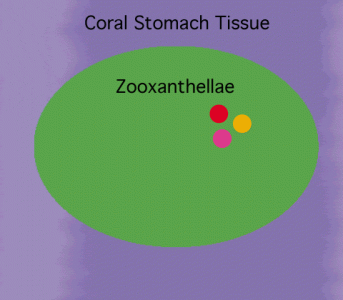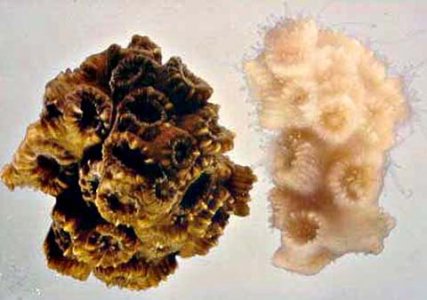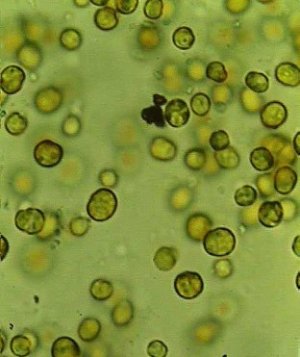Hi fellows
I found out this article below and would like to share with you guys. I thought very instructive, clear, small and easy to understand. See below:
Most reef-building corals contain photosynthetic algae, called zooxanthellae, that live in their tissues. The corals and algae have a mutualistic relationship. The coral provides the algae with a protected environment and compounds they need for photosynthesis. In return, the algae produce oxygen and help the coral to remove wastes. Most importantly, zooxanthellae supply the coral with glucose, glycerol, and amino acids, which are the products of photosynthesis. The coral uses these products to make proteins, fats, and carbohydrates, and produce calcium carbonate (Barnes, R.D., 1987; Barnes, R.S.K. and Hughes, 1999; Lalli and Parsons, 1995; Levinton, 1995; Sumich, 1996).
The relationship between the algae and coral polyp facilitates a tight recycling of nutrients in nutrient-poor tropical waters. In fact, as much as 90 percent of the organic material photosynthetically produced by the zooxanthellae is transferred to the host coral tissue (Sumich, 1996).
This is the driving force behind the growth and productivity of coral reefs (Barnes, 1987; Levinton, 1995).

Tiny plant cells called zooxanthellae live within most types of coral polyps. They help the coral survive by providing it with food resulting from photosynthesis. In turn, the coral polyps provide the cells with a protected environment and the nutrients they need to carry out photosynthesis.
In addition to providing corals with essential nutrients, zooxanthellae are responsible for the unique and beautiful colors of many stony corals. Sometimes when corals become physically stressed, the polyps expel their algal cells and the colony takes on a stark white appearance. This is commonly described as "œcoral bleaching" (Barnes, R.S.K. and Hughes, 1999; Lalli and Parsons, 1995).
If the polyps go for too long without zooxanthellae, coral bleaching can result in the coral's death.


Coral polyps, which are animals, and zooxanthellae, the plant cells that live within them, have a mutualistic relationship. Coral polyps produce carbon dioxide and water as byproducts of cellular respiration. The zooxanthellae cells use the carbon dioxide and water to carry out photosynthesis. Sugars, lipids (fats) and oxygen are some of the products of photosynthesis which the zooxanthellae cells produce. The coral polyp then uses these products to grow and carry out cellular respiration. The tight recycling of products between the polyp cells and the zooxanthellae is the driving force behind the growth and productivity of coral reefs. This animation shows how the products created by the algal polyp and zooxanthellae cells are provided to each other for their mutual benefit.
Because of their intimate relationship with zooxanthellae, reef-building corals respond to the environment like plants. Because their algal cells need light for photosynthesis, reef corals require clear water. For this reason they are generally found only in waters with small amounts of suspended material, i.e., in water of low turbidity and low productivity. This leads to an interesting paradox "”coral reefs require clear, nutrient-poor water, but they are among the most productive and diverse marine environments (Barnes, 1987).

Zooxanthellae cells provide corals with pigmentation. On the left is a healthy stony coral. On the right is a stony coral that has lost its zooxanthellae cells and has taken on a bleached appearance. If a coral polyp is without zooxanthellae cells for a long period of time, it will most likely die.
Maybe by this article, it's time to take care when our soft corals start to be white.:thumbsup:
Regards
Bulabr
I found out this article below and would like to share with you guys. I thought very instructive, clear, small and easy to understand. See below:
Most reef-building corals contain photosynthetic algae, called zooxanthellae, that live in their tissues. The corals and algae have a mutualistic relationship. The coral provides the algae with a protected environment and compounds they need for photosynthesis. In return, the algae produce oxygen and help the coral to remove wastes. Most importantly, zooxanthellae supply the coral with glucose, glycerol, and amino acids, which are the products of photosynthesis. The coral uses these products to make proteins, fats, and carbohydrates, and produce calcium carbonate (Barnes, R.D., 1987; Barnes, R.S.K. and Hughes, 1999; Lalli and Parsons, 1995; Levinton, 1995; Sumich, 1996).
The relationship between the algae and coral polyp facilitates a tight recycling of nutrients in nutrient-poor tropical waters. In fact, as much as 90 percent of the organic material photosynthetically produced by the zooxanthellae is transferred to the host coral tissue (Sumich, 1996).
This is the driving force behind the growth and productivity of coral reefs (Barnes, 1987; Levinton, 1995).
Tiny plant cells called zooxanthellae live within most types of coral polyps. They help the coral survive by providing it with food resulting from photosynthesis. In turn, the coral polyps provide the cells with a protected environment and the nutrients they need to carry out photosynthesis.
In addition to providing corals with essential nutrients, zooxanthellae are responsible for the unique and beautiful colors of many stony corals. Sometimes when corals become physically stressed, the polyps expel their algal cells and the colony takes on a stark white appearance. This is commonly described as "œcoral bleaching" (Barnes, R.S.K. and Hughes, 1999; Lalli and Parsons, 1995).
If the polyps go for too long without zooxanthellae, coral bleaching can result in the coral's death.
Coral polyps, which are animals, and zooxanthellae, the plant cells that live within them, have a mutualistic relationship. Coral polyps produce carbon dioxide and water as byproducts of cellular respiration. The zooxanthellae cells use the carbon dioxide and water to carry out photosynthesis. Sugars, lipids (fats) and oxygen are some of the products of photosynthesis which the zooxanthellae cells produce. The coral polyp then uses these products to grow and carry out cellular respiration. The tight recycling of products between the polyp cells and the zooxanthellae is the driving force behind the growth and productivity of coral reefs. This animation shows how the products created by the algal polyp and zooxanthellae cells are provided to each other for their mutual benefit.
Because of their intimate relationship with zooxanthellae, reef-building corals respond to the environment like plants. Because their algal cells need light for photosynthesis, reef corals require clear water. For this reason they are generally found only in waters with small amounts of suspended material, i.e., in water of low turbidity and low productivity. This leads to an interesting paradox "”coral reefs require clear, nutrient-poor water, but they are among the most productive and diverse marine environments (Barnes, 1987).
Zooxanthellae cells provide corals with pigmentation. On the left is a healthy stony coral. On the right is a stony coral that has lost its zooxanthellae cells and has taken on a bleached appearance. If a coral polyp is without zooxanthellae cells for a long period of time, it will most likely die.
Maybe by this article, it's time to take care when our soft corals start to be white.:thumbsup:
Regards
Bulabr




